
Have you noticed red dots suddenly appearing on your skin?
Or maybe a single red dot, and you wonder how long it’s been there on your skin?
Could melanoma skin cancer first appear as a red dot, or is a red little spot on the skin usually harmless?
I have the answers, because I asked these questions to Dr. Oanh Lauring, MD, founder of Lauring Dermatology in Nottingham, MD.
Many people notice “dots” on their skin, and these skin dots or spots appear to be red.
This article is about red dots or spots (which may be elevated) on the skin, rather than red bumps or blemish-like spots.
“Red dots” on the skin can appear in many different ways.
One way is the appearance of pinpoint size specks. Let’s talk about these first.
The closer you examine your skin, the more of these tiny specks you may discover.
Some can be a little larger, like the size that a ball point pen would make, and then even larger yet, like 1-2 millimeters, even up to three mm.
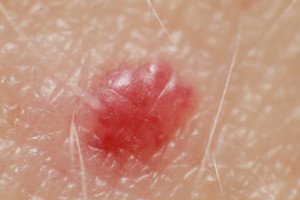
A cherry angioma. Shutterstock/dba87
Upon close inspection, you realize that these “red dots” aren’t necessarily dot shaped, but can be erratically shaped, as small as they are.
They may also appear a dark red, a bit off-red or a dark pink.
Some people have loads of these all over their body (particularly the back and chest).
These are called cherry angiomas and are completely harmless (see the two images above of harmless angiomas, also known as hemangiomas).
They are blood vessels above the surface of the skin, come with age (though there’s an isolated version that’s present since birth and may be quite large), and will never become a problem.
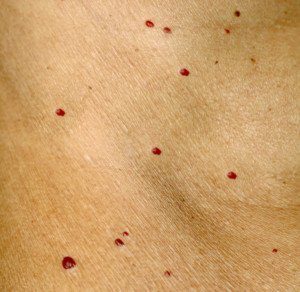
More angiomas. Shutterstock/Timonina
Other causes of red dots or spots on the skin, says Dr. Lauring:
“Pinpoint red dots: causes include leukocyclastic vasculitis (usually benign inflammation of the capillaries that can be associated with infections, medications, autoimmune processes), Schamberg’s disease (benign disorder presenting as cayenne pepper like red dots on the lower legs of older people), extravasation of blood into the skin caused by scratching and damaging the capillaries.
Bigger red or swollen dots around the ankles: may be bug bite reactions (mosquitoes, bed bugs, scabies, chiggers).”
Extravasation
It’s easy to cause this without knowing it. If you notice a new reddish dot, spot or speck under your eyes, under your brows or near the bridge of your nose, don’t fear skin cancer.
This is most likely an extravasation caused by scratching there, or even by simply pressing a nail there to relieve an itch.
One little nail press is all it may take to damage tiny capillaries. This is harmless.
Extravasation is “leakage of red blood cells from after there is trauma to the blood vessel wall,” says Dr. Lauring.
This is what happens when a person plays volleyball for the first time or after a long absence, allowing the ball to smack repeatedly against the bare underside of their forearms.
Multitudes of red dots will appear later on.
Extravasation spots disappear in several days, often taking on an orange tinge as they fade.
You should get acquainted with what cherry angiomas look like, versus extravasation spots.
Both can be described as “little red dots on the skin,” yet both look completely different from each other.
Another cause is atopic dermatitis. Psoriasis, too, can create little red dots or spots on the skin.
Melanoma
Melanoma skin cancer can present as a tiny red dot.
Images of melanoma on the Web usually show brown, purplish and black blotches.
But melanoma can present as a small red spot on the skin.
Below are three images of what this can look like.
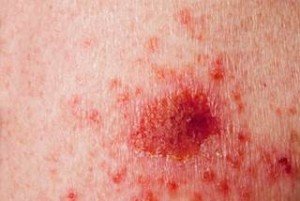
Melanoma. Cancertherapyadviso.com
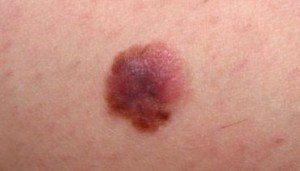
Melanoma. Nejm.org
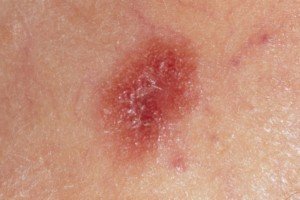
Melanoma. Nhs.uk
A man I know was diagnosed with melanoma at age 27. He showed me two melanoma spots near his wrist: two tiny red dots.
However, do not let this be reason to panic if you discover red dots on your skin.
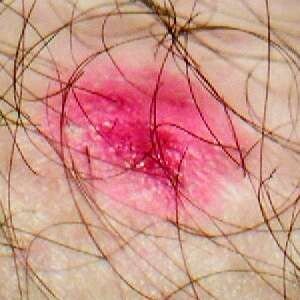
A small eczema patch
The bottom line: If a “red dot” does not go away, then consult with a dermatologist to make sure it’s nothing concerning.
Angiomas will not disappear, but it’s important to know how to recognize these.
 Dr. Lauring is former chief of dermatology at Mercy Medical Center. Lauring Dermatology provides medical and cosmetic services including for skin cancer, acne, psoriasis, hair and nail problems, and skin rejuvenation.
Dr. Lauring is former chief of dermatology at Mercy Medical Center. Lauring Dermatology provides medical and cosmetic services including for skin cancer, acne, psoriasis, hair and nail problems, and skin rejuvenation.
 Lorra Garrick has been covering medical, health and personal security topics for many years, having written thousands of feature articles for a variety of print magazines and websites. She is also a former ACE-certified personal trainer.
Lorra Garrick has been covering medical, health and personal security topics for many years, having written thousands of feature articles for a variety of print magazines and websites. She is also a former ACE-certified personal trainer.

























